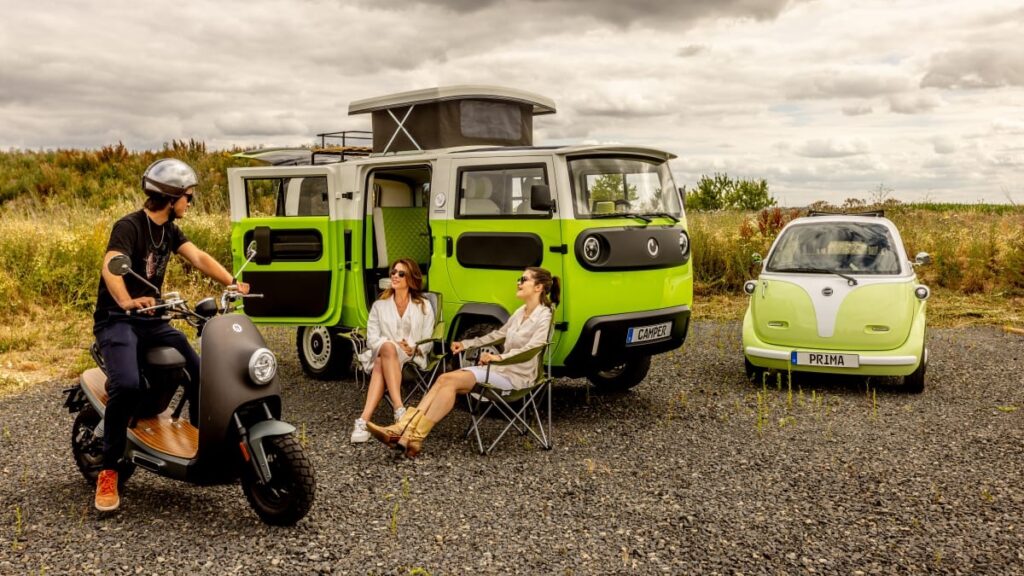Automotive newcomer gives a glimpse behind the scenes – World premiere for the XBUS Camper

The new light electric vehicle “Evetta” is reminiscent of the 1950s. A particularly striking feature is the forward-opening door. Evetta was formerly called “Karo” and was designed by the former vehicle manufacturer Artega. Since spring 2022, Artega has been fully integrated into the ElectricBrands group of companies. The vehicle is almost ready for production and is being developed at the Göttingen site. The first Evettas are to be delivered to customers next year.
Evetta can be ordered online
The electric runabout for urban areas can be pre-ordered in the ElectricBrands online shop at www.Evetta.com from 22 July onwards. Customers can look forward to a special vehicle for a new way of transportation. With its urban dimensions (length of 2.48 metres, width of 1.50 metres), the Evetta can park crosswise and takes up little parking space. With a range of up to 200 kilometres, the electric vehicle is ideally equipped for the city and its surroundings. At the same time, the Evetta reaches a top speed of 90 km/h – emission-free, of course!
Premiere for the XBUS Camper
At the event, ElectricBrands displays further additions to the family. Among them is the next prototype of the XBUS, the “Camper”, which is at the top of customers’ reservation lists. In addition, the electric scooters from the ElectricBrands product line NITO can be seen and ridden: For example, the N1e, an electric pedal scooter with a 240 watt motor. Riders can ride it at a speed of 20 km/h and have a range of 20 kilometres. More nimble is the NES series. The NES5 and NES10 e-scooters are 45 km/h and 90 km/h respectively and have a range of up to 90 kilometres, depending on the riding mode. The e-two-wheelers will be available for order via mynito.com from mid-July.
LEVs important for traffic turnaround
XBUS and Evetta are representative of the new generation of light electric vehicles. They can play an important role for the traffic turnaround, because they consume little energy, are space-saving and more efficient than large and heavy (electric) vehicles. The German Aerospace Centre, DLR, supports this thesis with a current study on LEVs (Light Electric Vehicles). Up to 57 million tonnes of CO2 could be saved per year through their use. “The potential of LEVs to support climate protection is considerable.”
Call for promotion
ElectricBrands CEO Martin Henne therefore wants to convince politicians to include light electric vehicles in the 2023 amendment to the subsidy law. “We need a strong, nationwide, uniformly regulated subsidy for light electric vehicles” Henne demands and further explains: “This future car classification is elementary for a successful, sustainable traffic turnaround. Instead of ever heavier, more expensive electric vehicles, we must focus more on light weight, low consumption and reduced parking space.”
Premium is up for debate
Start-up funding for electric cars is central to the transport turnaround. Currently, there are about 620,000 registered electric cars. Depending on the definition, plug-in hybrid cars also count as electric cars. Until the end of the so-called innovation premium at the end of 2022, buyers will receive up to 9,000 euros in subsidies for e-cars. The environmentally friendly LEVs are not yet included here. “It is likely that the debate on the subsidy for light electric vehicles will pick up even more speed this year,” says Henne. “We have a good chance. The premium for light electric vehicles is not off the table.”
At the multi-day event, there will be days for the press (6 July), for vehicle dealers (7/8 July) and for the public (9/10 July). Here, interested parties can test ride NITO bikes and Evetta, after prior registration.





